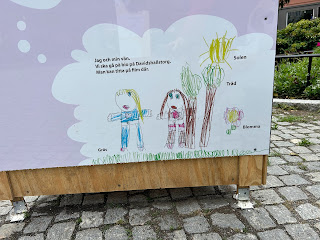In my short time in Malmö, I have noticed significantly fewer playgrounds and
spaces for children compared to Copenhagen. You’d think in a less dense city
with more dedication to green space, there would be more playgrounds but alas.
However, in my walking journey today for souvenirs, a raincoat, and chocolate,
I wandered into an exhibit in a square called Dröm Torg (Dream Square). This
empty square, half was taken up by a surface parking lot, featured art by children
of what they imagined as their “Dream Square”. This exhibit showed squares
filled with trees, flowers, bushes, playgrounds, and an occasional snake or
clown. They’re was also a common theme of readily available ice cream near the
square in the children's drawings. I really enjoyed this exhibit, and hope it is
more than just an exhibit and actually comes to fruition. Not just engaging
children with society through safe public spaces, but engaging them with the
creation of the space, is a great way to incorporate them into the community and
make them feel valued and wanted. Other great additions to the space could
include things like the traffic garden in Copenhagen and ample bike parking. The
park was not well connected along the bike network in Malmö. This is one
improvement I would recommend to the space. It already had a plethora of
restaurants and commercial businesses surrounding the square and was in a
residential area. The removal of the surface parking lot and replacing it with a
child-centered space that is connected to the bike network would improve the
quality and safety of the area for both children and adults.
 |
| "Me and my friend. We're going to the cinema in Davidshall. We will watch movies there" I like this one because the child artist mentions movies in her description but the picture is full of sun, flowers, trees, and grass. |
 |
| One of the more traditional drawings, some bushes, and a tire swing. |
 |
| Definitely a more abstract one! "This is a grass, twigs, and leaves. It is a tree that has hidden a statue" Creative! |
 |
| Another common thing children wanted in their parks were sprinklers and water features. |
 |
| this one was my favorite, not really sure what's going on. |
 |
Translation:
DREAM SQUARE
From Förskolan Björnen
During the spring, children aged 4-6 from Björnen preschool met urban developers from the city of Malmö to talk about, think about and draw their "dream squares". In this exhibition you can see the results of the children's thoughts and work. The term "Drömtorg" can be interpreted in different ways in the exhibition. Sometimes the children's dreams and wishes are clearly reflected in the motifs and show a future for Davidshall from their perspective. In other cases, the children's thoughts themselves become dreamy and show other things than those we adults automatically associate with the city's public spaces. In the motifs we can discern different stories, moods and reactions to the task of drawing one's dream square. The hope is that the children's words and works can help us broaden our views and think more broadly about how the square affects us in different ways. The city's public environments must be for everyone - even those who are not loud. Look, read and enjoy the children's work, and feel free to leave your own thoughts about the square's future through the QR code on the signs you find in the square. Thanks ! |
The QR code leads you to a survey asking about enjoyment of the space and what activities people would like to see and currently use. It gathers public opinion from the parents bringing their children and other people in the area.






So curious what you find out about kids, play and Amsterdam.
ReplyDelete